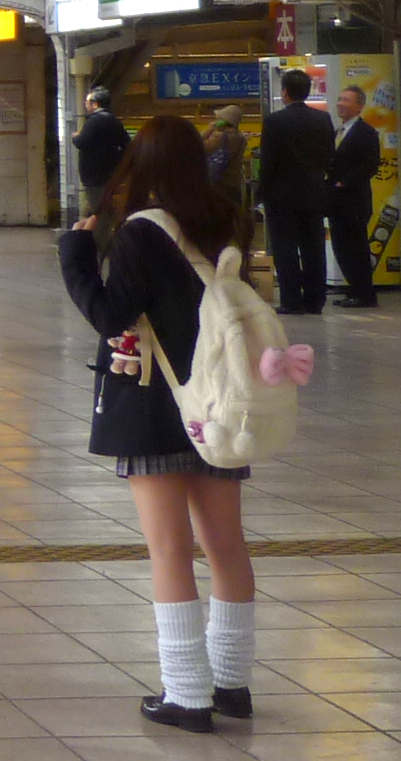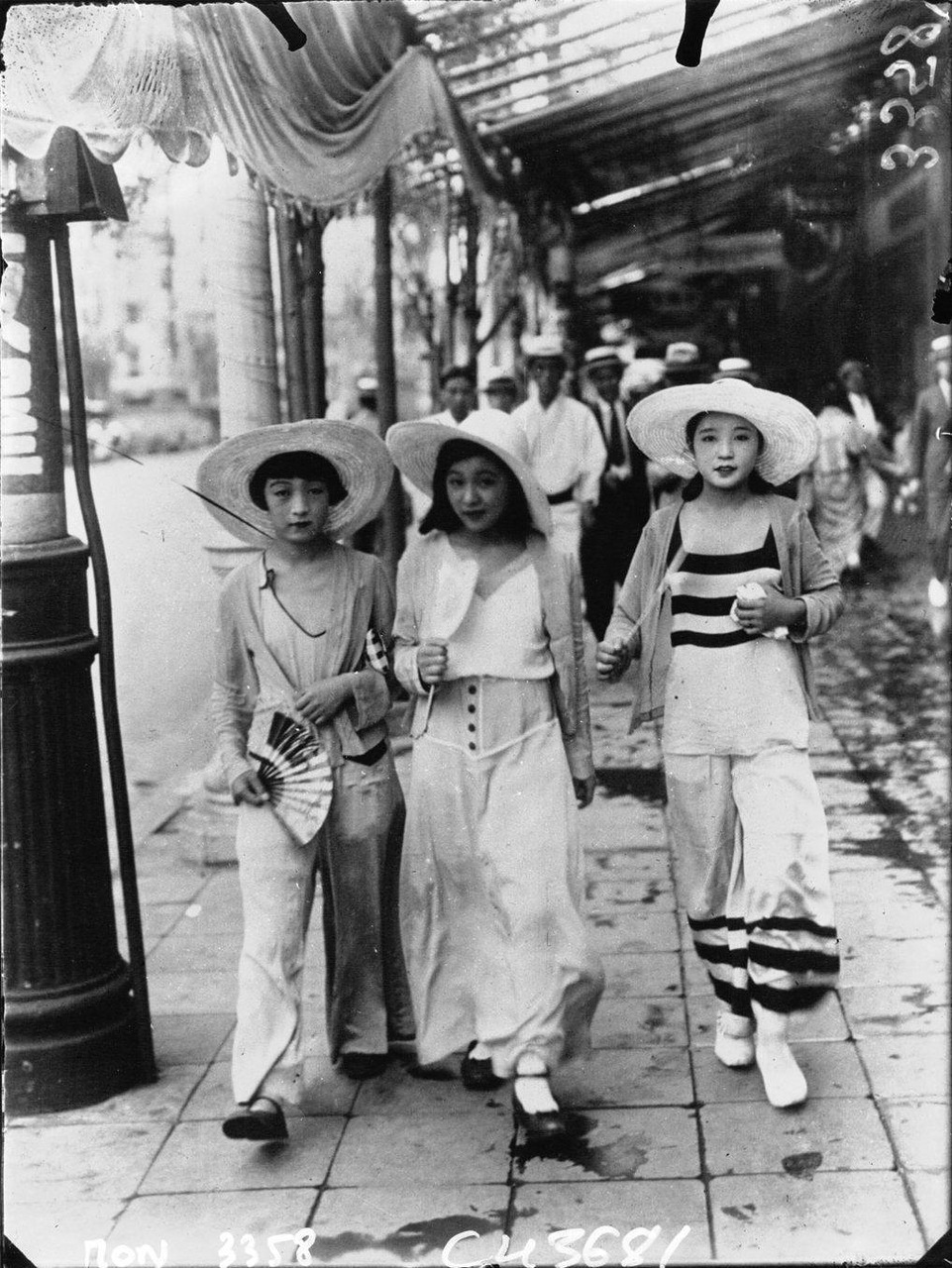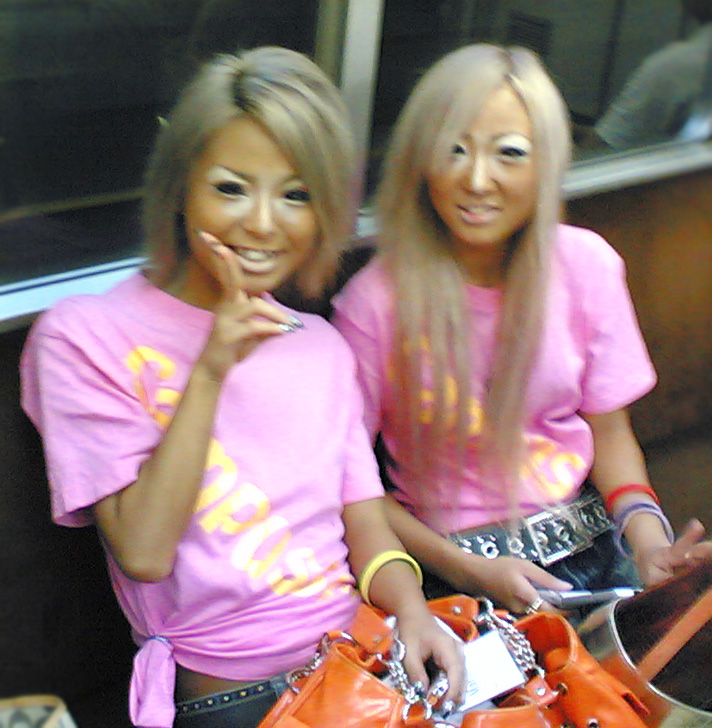|
Kogal
is a Japanese fashion culture that involves schoolgirls wearing an outfit based on Japanese school uniforms (or their actual uniforms) but with very short skirts. The short skirts are worn irrespective of the season. The girls may also wear loose socks and scarves, and have dyed hair. The word ''kogal'' is anglicized from , a contraction of ("high school gal"). The girls refer to themselves as ("gals"), although this word is applied to several other fashion looks as well. Aside from the miniskirt or microskirt, and the loose socks, kogals favor platform boots, makeup, and Burberry check scarves; some kogals carry accessories considered kawaii or cute. They may also dye their hair brown and get artificial suntans. They have a distinctive slang peppered with English words. They are often, but not necessarily, enrolled students. Centers of kogal culture include the Harajuku and Shibuya Shibuya ( 渋谷 区 ''Shibuya-ku'') is a special ward in Tokyo, Japan. As a major c ... [...More Info...] [...Related Items...] OR: [Wikipedia] [Google] [Baidu] |
Gyaru
( ja, ギャル) , is a Japanese fashion subculture. The term ''gyaru'' is a Japanese transliteration of the English slang word . The term for was introduced in Japan by the American jeans company ''Lee'', who introduced a new line of jeans to their brand ''Wrangler''. When the women's jeans line 'GALS' was released in the 1970s; the term had been quickly used outside of its original branding and was adopted to describe the fashion by 1972. subculture was at its peak during the Heisei era. It had a large influence on Japanese fashion and its economy, its international economy, and its global soft power across the world through Cool Japan such as in Southeast Asia and internationally. Multiple brands branched out before eventually declining due to financial instability and changes in its target demographic. The terms usage peaked in the early 2000s and has gradually declined since. This decline has been attributed to shifts in magazine industry, the exaggeration of the ... [...More Info...] [...Related Items...] OR: [Wikipedia] [Google] [Baidu] |
Japanese School Uniform
The Japanese school uniform is modeled in appearance similar to that of the European-style naval uniforms. It was first used in Japan in the late 19th century, replacing the traditional kimono. Today, school uniforms are common in many of the Japanese public and private school systems. The Japanese word for this type of uniform is . History The majority of Japan's junior high and high schools require students to wear uniforms. The Japanese school uniform is not only a symbol of youth but also plays an important role in the country's culture, as they are felt to help instill a sense of discipline and community among youth. There are many types of uniforms that range from standard to unique ones varying in the ensembles used. Japanese school uniforms have been around for 150 years. Originally students just wore standard everyday clothes to school; kimono for female students, with for male students. During the Meiji period, students began to wear uniforms modelled after Weste ... [...More Info...] [...Related Items...] OR: [Wikipedia] [Google] [Baidu] |
Enjo Kōsai
is a type of transactional relationship similar to the western equivalent being a call girl of Sugaring. It is the Japanese language term for the practice of older men giving money and/or luxury gifts to attractive young women for sexual favors. The female participants range from school girls (or JK business) to housewives. The term is often translated as "compensated dating" or "subsidized dating". The opposite case of women paying men, , is not a documented social phenomenon, but fraudulent solicitations from fictive women offering to pay for sex is a common tactic in phishing emails. Definition The most common connotation of the term enjo-kosai in Japan is that it is a form of child prostitution whereby participating girls sell their bodies in exchange for designer goods or money. However, some organizations and writers have argued that enjo-kōsai is distinct from prostitution, and can include just spending time together for compensation. Some women's centers in Japan, ... [...More Info...] [...Related Items...] OR: [Wikipedia] [Google] [Baidu] |
Kawaii
''Kawaii'' is the culture of cuteness in Japan. It can refer to items, humans and non-humans that are charming, vulnerable, shy and childlike.Kerr, Hui-Ying (23 November 2016)"What is kawaii – and why did the world fall for the ‘cult of cute’?", ''The Conversation''. Examples include cute handwriting, certain genres of manga, anime, and characters including Hello Kitty and Pikachu. The cuteness culture, or ''kawaii'' aesthetic, has become a prominent aspect of Japanese popular culture, entertainment, clothing, food, toys, personal appearance, and mannerisms. Etymology The word ''kawaii'' originally derives from the phrase ''kao hayushi'', which literally means "(one's) face (is) aglow," commonly used to refer to flushing or blushing of the face. The second morpheme is cognate with ''-bayu'' in '' mabayui'' (眩い, 目映い, or 目映ゆい) "dazzling, glaring, blinding, too bright; dazzlingly beautiful" (''ma-'' is from ''me'' "eye") and ''-hayu'' in ''omohayui'' (� ... [...More Info...] [...Related Items...] OR: [Wikipedia] [Google] [Baidu] |
Kawaii
''Kawaii'' is the culture of cuteness in Japan. It can refer to items, humans and non-humans that are charming, vulnerable, shy and childlike.Kerr, Hui-Ying (23 November 2016)"What is kawaii – and why did the world fall for the ‘cult of cute’?", ''The Conversation''. Examples include cute handwriting, certain genres of manga, anime, and characters including Hello Kitty and Pikachu. The cuteness culture, or ''kawaii'' aesthetic, has become a prominent aspect of Japanese popular culture, entertainment, clothing, food, toys, personal appearance, and mannerisms. Etymology The word ''kawaii'' originally derives from the phrase ''kao hayushi'', which literally means "(one's) face (is) aglow," commonly used to refer to flushing or blushing of the face. The second morpheme is cognate with ''-bayu'' in '' mabayui'' (眩い, 目映い, or 目映ゆい) "dazzling, glaring, blinding, too bright; dazzlingly beautiful" (''ma-'' is from ''me'' "eye") and ''-hayu'' in ''omohayui'' (� ... [...More Info...] [...Related Items...] OR: [Wikipedia] [Google] [Baidu] |
Modern Girl
(also shortened to ) were Japanese women who followed Westernized fashions and lifestyles in the period after World War I. were Japan's equivalent of America's flappers, Germany's , France's , or China's (). By viewing through a Japanese versus Western lens, the nationalist press could use the modern girl archetype to blame such failings as frivolity, sexual promiscuity, and selfishness on foreign influence.''The Gender/Sexuality Reader: Culture, History, Political Economy'', edited by Roger N. Lancaster and Micaela Di Leonardo, pp. 493-494 The period was characterized by the emergence of working class young women with access to money and consumer goods. Using aristocratic culture as their standard of Japaneseness, the critics of the modern girl condemned her working class traits as "unnatural" for Japanese. Modern girls were depicted as living in the cities, being financially and emotionally independent, choosing their own suitors, and apathetic towards politics. [...More Info...] [...Related Items...] OR: [Wikipedia] [Google] [Baidu] |
Ganguro
is a fashion trend among young Japanese women that started in the mid-1990s, distinguished by a dark tan and contrasting make-up liberally applied by fashionistas. The Shibuya and Ikebukuro districts of Tokyo were the centres of ''ganguro'' fashion; it was started by rebellious youth who contradicted the traditional Japanese concept of beauty; pale skin, dark hair and neutral makeup tones. ''Ganguro'' instead tanned their skin, bleached their hair and used much colourful makeup in unusual ways. ''Ganguro'' has a connection to Japanese folklore of ghosts and demons who are depicted with a similar appearance such as those in kabuki and noh costumes. This connection is further underlined by the off-shoot style ''yamanba'', named after a mountain witch in Japanese folklore. The ''ganguro'' trend started in the mid-1990s and reached its peak by the latter half of the decade; it purportedly became almost obsolete by 2000 when a bihaku (light skin) craze emerged among young women who ... [...More Info...] [...Related Items...] OR: [Wikipedia] [Google] [Baidu] |
Burberry
Burberry is a British luxury fashion house established in 1856 by Thomas Burberry headquartered in London, England. It currently designs and distributes ready to wear, including trench coats (for which it is most famous), leather accessories, and footwear. Its name and branding are licensed to Coty for fragrances and cosmetics and to Luxottica for eyewear. History Early years, 19th century Burberry was founded in 1856 when 21-year-old Thomas Burberry, a former draper's apprentice, opened his own store in Basingstoke, Hampshire, England. By 1870, the business had established itself by focusing on the development of outdoors attire. In 1879, Burberry introduced gabardine to his brand, a hardwearing, water-resistant yet breathable fabric, in which the yarn is waterproofed before weaving. In 1891, Burberry opened a shop in the Haymarket, London. 20th century In 1901, the Burberry Equestrian Knight logo was developed containing the Latin word "Prorsum", meaning "forwards", and ... [...More Info...] [...Related Items...] OR: [Wikipedia] [Google] [Baidu] |
Parasite Single
A is a single person who lives with their parents beyond their late 20s or early 30s to enjoy a more carefree and comfortable life. In Japanese culture, the term is especially used when negatively describing young unmarried women. Etymology The expression ''parasaito shinguru'' was first used by Professor Masahiro Yamada of Tokyo Gakugei University in his bestselling book , published in October 1999. The catchy phrase quickly found its way into the media and is now a well-known expression in Japan. Professor Yamada subsequently coined the related term ''parasite couple'' to refer to married children living with the parents of one partner. However, this situation occurs less frequently and the term ''parasite couples'' is less well known. This is a traditional Japanese living arrangement, though its prevalence has decreased in recent years. Dynamics This situation allows the children to live in considerable comfort, and while many save money, others spend all their income on lux ... [...More Info...] [...Related Items...] OR: [Wikipedia] [Google] [Baidu] |
Masato Harada
is a Japanese film director, film critic, and sometimes an actor; he is best known to foreign audiences as Omura in ''The Last Samurai'' and as Mr Mita in ''Fearless (2006 film), Fearless''. In both his acting roles he portrayed the villain who wants Japan to westernize under the Meiji Restoration in the meantime trying to remove the old ways. Early life Harada was born in Numazu, Shizuoka and graduated from Higashi High School. In 1972 he went to London to learn English. He then attended Tokyo College of Photography and Pepperdine University, where he spent number of years training as a filmmaker. He married journalist Mizuho Fukuda in 1976. Career Harada made his directorial debut in 1979. He collaborated and showcased his works in Europe and US and worked as an English to Japanese subtitle (captioning), subtitle translator for number of American films showing in Japan. As an actor, he appeared in Edward Zwick's ''The Last Samurai'' in 2003. and Ronny Yu's ''Fearless (2006 fil ... [...More Info...] [...Related Items...] OR: [Wikipedia] [Google] [Baidu] |
Bounce Ko Gals
is a 1997 Japanese crime drama film written and directed by Masato Harada. Its alternative English-language titles are ''Call Girls'' and ''Leaving''. Filmed in somewhat of a documentary style , it follows the course of three girls for a day and a night In the popular district of Shibuya in Tokyo. The main characters are : Jonko ( Hitomi Satô), who runs a group of high-school girls involved in paid dating (in Japanese Enjo Kôsai 援助交際) , Raku (Yasue Sato) who is a high-schooler and also a street dancer; and Lisa ( Yukiko Okamoto) who is a student , who worked for a year, saving enough money and a plane ticket , to go study in New York. Cast * Hitomi Satō as Jonko * Yasue Sato as Raku-chan * Yukiko Okamoto as Risa * Kōji Yakusho as Ōshima * Jun Murakami as Sap * Shin Yazawa as Maru * Kaori Momoi as Saki * Maori as Kuji * Kaitō Ren as Shingo * Yūjin Harada as Moro * Hiroshige Ikeda as Neon * Hitoshi Kiyokawa as Tera * Kazuki Kosakai as Koide Awards and nominati ... [...More Info...] [...Related Items...] OR: [Wikipedia] [Google] [Baidu] |
Independent
Independent or Independents may refer to: Arts, entertainment, and media Artist groups * Independents (artist group), a group of modernist painters based in the New Hope, Pennsylvania, area of the United States during the early 1930s * Independents (Oporto artist group), a Portuguese artist group historically linked to abstract art and to Fernando Lanhas, the central figure of Portuguese abstractionism Music Groups, labels, and genres * Independent music, a number of genres associated with independent labels * Independent record label, a record label not associated with a major label * Independent Albums, American albums chart Albums * ''Independent'' (Ai album), 2012 * ''Independent'' (Faze album), 2006 * ''Independent'' (Sacred Reich album), 1993 Songs * "Independent" (song), a 2007 song by Webbie * "Independent", a 2002 song by Ayumi Hamasaki from '' H'' News and media organizations * ''The Independent'', a British online newspaper. * ''The Malta Independent'', a Mal ... [...More Info...] [...Related Items...] OR: [Wikipedia] [Google] [Baidu] |

.jpg)


.jpg)

